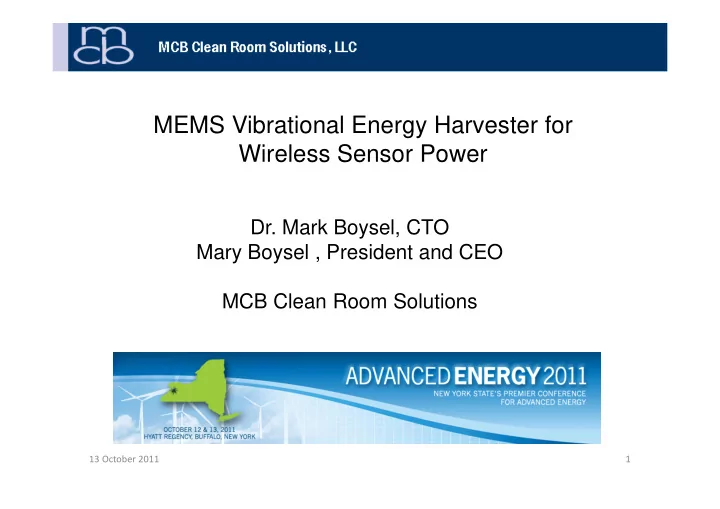

MEMS Vibrational Energy Harvester for Wireless Sensor Power Dr. Mark Boysel, CTO Mary Boysel , President and CEO MCB Clean Room Solutions 13 October 2011 1
Micro-Vibrational Energy Harvester ( µ VEH) � MCB is developing a MEMS (Micro-Electro-Mechanical Systems) piezoelectric µ VEH to power wireless sensors. • Converts environmental vibrations into electricity • Replaces or recharges batteries • Goal is 3 V, 0.1-1mW in a single piezo element • Package target: < 1cm 2 footprint, < 1cm 3 volume � Targeting Building Controls and HVAC • Rich source of 120 Hz vibrations • 3% of Wireless Sensor Market • Largest market for low power energy harvesters 13 October 2011 2
The Opportunity – Wireless Sensor Networks � Wireless Sensor Networks (WSN) market estimated to reach $7.8B by 2015 • Sensors for infrastructure, industrial processes, security • Energy and cost savings by monitoring processes, energy use � Batteries need to be changed • Embedded sensors (e.g. HVAC) are difficult to access • Cost of changing batteries ~ $2/year/battery ($2 B annually) • Up to 90% of potential wireless apps not attempted because of battery changes � Wireless sensors need to be self-powered – Energy scavengers � Market for low power energy harvesters for buildings estimated at $75M in 2009 growing at 74% AAGR to $1.2B in 2014 13 October 2011 3
Why Vibrational Energy Harvesters? � Several other energy harvesting technologies available • Not ideal for Building Controls and HVAC • Solar - Light may not be available in embedded sensor locations in buildings and HVAC • Thermal - Requires a temperature gradient that may not be available in an embedded environment • RF – Requires an external power transmission source � Vibrational harvesters can use vibrations of electrical equipment and motors in buildings • Electromagnetic – Coil and magnet tend to be large, expensive • Piezoelectric – Materials have historically been difficult to work with 13 October 2011 4
Why MEMS? � For widespread use Wireless Sensors (WS) will require small (< 1cm 3 , 1cm 2 footprint), inexpensive (<$10) power sources. � Macro- Energy Harvesters provide plenty of power but are large and expensive. System Wireless Sensor Thermal EH Transducer only Electromagnetic EH Piezoelectric EH � MEMS (Micro-Electro-Mechanical Systems) use volume semiconductor wafer manufacturing processes - Many parts per wafer • Small, inexpensive – Think $1 accelerometers 13 October 2011 5
The Problem With MEMS � Because they are small MEMS produce little power and operate at high frequencies. � Stress in piezoelectric produces voltage between faces • V = d 31 σ av / ϵ p t p , • Stress, σ = Y ∆ y/R, ∆ y=distance to neutral axis • For MEMS thin film processes ∆ y is small • Thin films are on the order of 1-2 µ m thick. � Use multiple cantilevers or multiple chips � Stress gradient curling 13 October 2011 6
MCB’s Solution � MEMS Thick Beam Process (Pat. App. US20110210554) • Proprietary process to create a cantilever that is thicker than is typical of conventional MEMS surface micromachining processes • Raises piezoelectric film ~10X further away from neutral axis • 100 x increase in power • Eliminates stress curling 13 October 2011 7
Scale Model Proof of Concept � Manually constructed spring and mass cantilevers at 25 X scale • Identical PZT (Lead Zirconate Titanate) sheets (2” x 0.5” x 0.005”) • Silver epoxied to brass shim cantilevers • Thin monomorph - 0.01” thick • Thick bimorph - 0.05” thick. � Lead proof masses added to equalize resonant frequencies (75 Hz) � Frequency spectra taken with fixed 220 kHz load instead of optimized load. � Output voltage ratio of thick bimorph to monomorph was 8V/0.2 V, or a factor of 40. • Corresponds to a power ratio of 1600 (non-optimized) 13 October 2011 8
MEMS Design and Power Modeling � Roundy and Wright developed an expression for the power output of a macro-VEH bimorph. � Optimize load resistance for ω . � Calculate P, V, Stress Piezo thickness = 0.5 um Cantilever thickness (m) Cantilever thickness (m) 13 October 2011 9
MEMS Design and Fabrication � Design splits for model verification • Frequency arrays • Designs around process splits • Adjust proof mass to match spring • Designs for fixed 120 Hz frequency � Fabrication at Cornell Nanoscale Science and Technology Facility (CNF) • Releasing first prototypes • Packaging and Testing this month 13 October 2011 10
Acknowledgements We are grateful for support from the National Science Foundation (NSF) and the New York State Energy Research and Development Authority (NYSERDA) We also wish to acknowledge assistance from Venture Creations for business and proposal support and to NYSTAR and the Cornell Center for Materials Research (CCMR) through the JumpStart Program. 13 October 2011 11
Recommend
More recommend